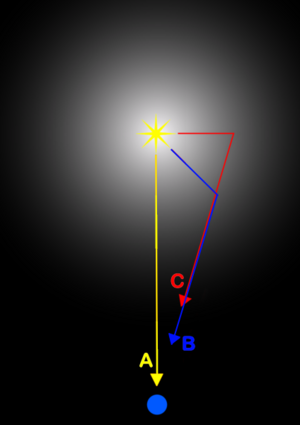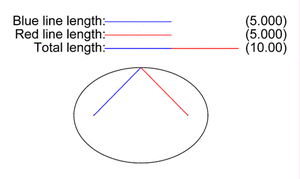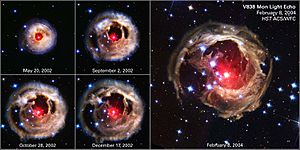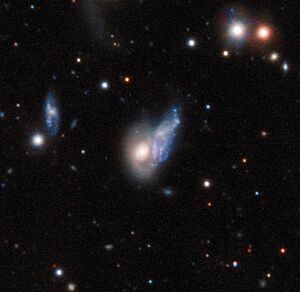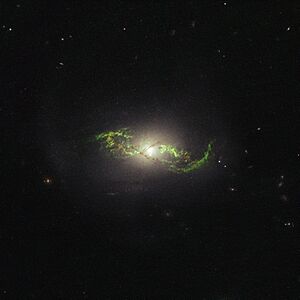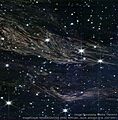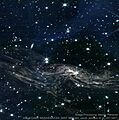Light echo facts for kids
A light echo is a cool space event where light from a sudden flash, like a star exploding, bounces off clouds of dust in space. This reflected light reaches us a bit later than the direct light from the flash. It's like an echo of sound, but with light! Because light travels incredibly fast, we only see these echoes over huge distances in space.
Sometimes, a light echo can make it look like something is moving faster than the speed of light. This is just an illusion, though, because of how the light reflects and travels through space.
Contents
How Light Echoes Work
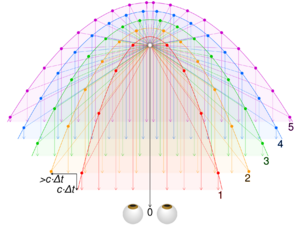
Light echoes happen when a very bright object, like a nova (a star that suddenly gets much brighter), sends out a flash of light. This light then hits clouds of space dust that are between the star and us. The direct light from the flash reaches our Earth first. But the light that bounces off the dust takes a longer path, so it arrives a little later.
Imagine the light flash as a ripple in a pond. The direct ripple reaches you first. Then, ripples that hit a rock and bounce off will reach you later. In space, this reflected light seems to expand outwards, sometimes appearing to move faster than light itself. This is because the light is reflecting off different parts of the dust cloud at different distances from us.
Look at the first picture above. Light following path A comes straight from the star to us. Light following path B bounces off a dust cloud closer to us. Light following path C bounces off a dust cloud further away. Even though B and C might look like they're in the same spot in the sky, B is actually much closer. So, the light from B arrives sooner than the light from C. This difference in arrival times makes the echo look like it's expanding super fast!
All the reflected light rays that reach Earth at the same time have traveled the exact same total distance. These paths form a special shape called an ellipsoid. The star's flash and Earth are at the two "focus points" of this ellipsoid. As time passes, this ellipsoid shape gets bigger and bigger.
Amazing Examples of Light Echoes
Light echoes help astronomers study events in space that happened long ago.
V838 Monocerotis's Outburst
In 2002, a star called V838 Monocerotis had a huge, sudden burst of light. When astronomers looked at it with the Hubble Space Telescope, they saw a light echo that seemed to expand incredibly fast. It grew from about 4 to 7 light years in just a few months! This was a stunning example of a light echo in action.
Supernovae and Their Echoes
Supernovae are powerful explosions of stars. Sometimes, we can see faint reflections of these ancient explosions using light echoes. Astronomers can figure out where dust clouds are by looking for these echoes. They compare photos taken months apart to spot the light rippling across the dust.
By studying the light's colors, scientists can learn about the chemicals from supernovae that exploded hundreds or even thousands of years ago. This helps them compare the explosion with what's left of the star today.
- SN 1987A: This was the closest supernova seen in modern times. Its light echoes have helped scientists map the dust clouds around it.
- SN 1572: This supernova was seen on Earth in 1572. In 2008, faint light echoes from it were spotted on dust in our Milky Way galaxy.
- Cassiopeia A: The light from the supernova that created Cassiopeia A would have reached Earth around 1660. But people didn't notice it, probably because dust blocked the view. Light echoes from Cassiopeia A showed that the explosion was not perfectly round; it shone brighter in some directions than others. This was the first time scientists saw such an "asymmetry" in a supernova in 2010.
- Eta Carinae: Light echoes from a huge eruption of the star Eta Carinae (which was like a "supernova imposter") helped scientists study it. They found that this eruption was colder than other similar events.
Measuring Distances with Cepheids
Light echoes have also been used to measure the distance to a special type of star called Cepheid variable RS Puppis. Scientists measured its distance with amazing accuracy, down to 1%! This is very important for understanding the size of our universe.
ShaSS 622-073 System
The ShaSS 622-073 system is made of two galaxies that are starting to merge. The brighter galaxy, ShaSS 073, used to have a very bright center. Even though its center has faded over the last 30,000 years, its light is still echoing off gas in the smaller galaxy, ShaSS 622. This makes the gas glow brightly, showing us a "ghost" of the past light!
Quasar Light Echoes
Since 2009, scientists have been studying something called "quasar light echoes" or "quasar ionization echoes." A quasar is like a super bright, active center of a galaxy, powered by a giant black hole.
A famous example is an object called Hanny's Voorwerp (HsV). HsV is a cloud of gas that is extremely hot, about 10,000 degrees Celsius! Scientists believe it's lit up by the "echo" of a quasar that used to be active but has now turned off.
Imagine a powerful flashlight that suddenly turns off. The light that has already traveled outwards will keep going. If that light hits something far away, it will still light it up, even if the flashlight is off. That's what happened with Hanny's Voorwerp. The galaxy IC 2497 used to have a super bright quasar. Even though that quasar turned off about 100,000 years ago, its light is still reaching and lighting up Hanny's Voorwerp. It's like a frozen moment in time for us to observe!
Gallery
-
Light echo at Eta Carinae
-
Light echo at Cassiopeia (north) played back and forth
-
Detailed view of the Cassiopeia A light echo with JWST NIRCam
See also
- Cherenkov radiation
- I Zwicky 1#Supermassive black hole, the first known example of light echo coming from the behind of a black hole.


